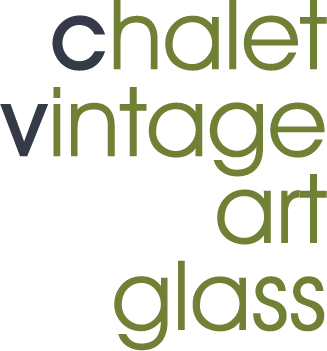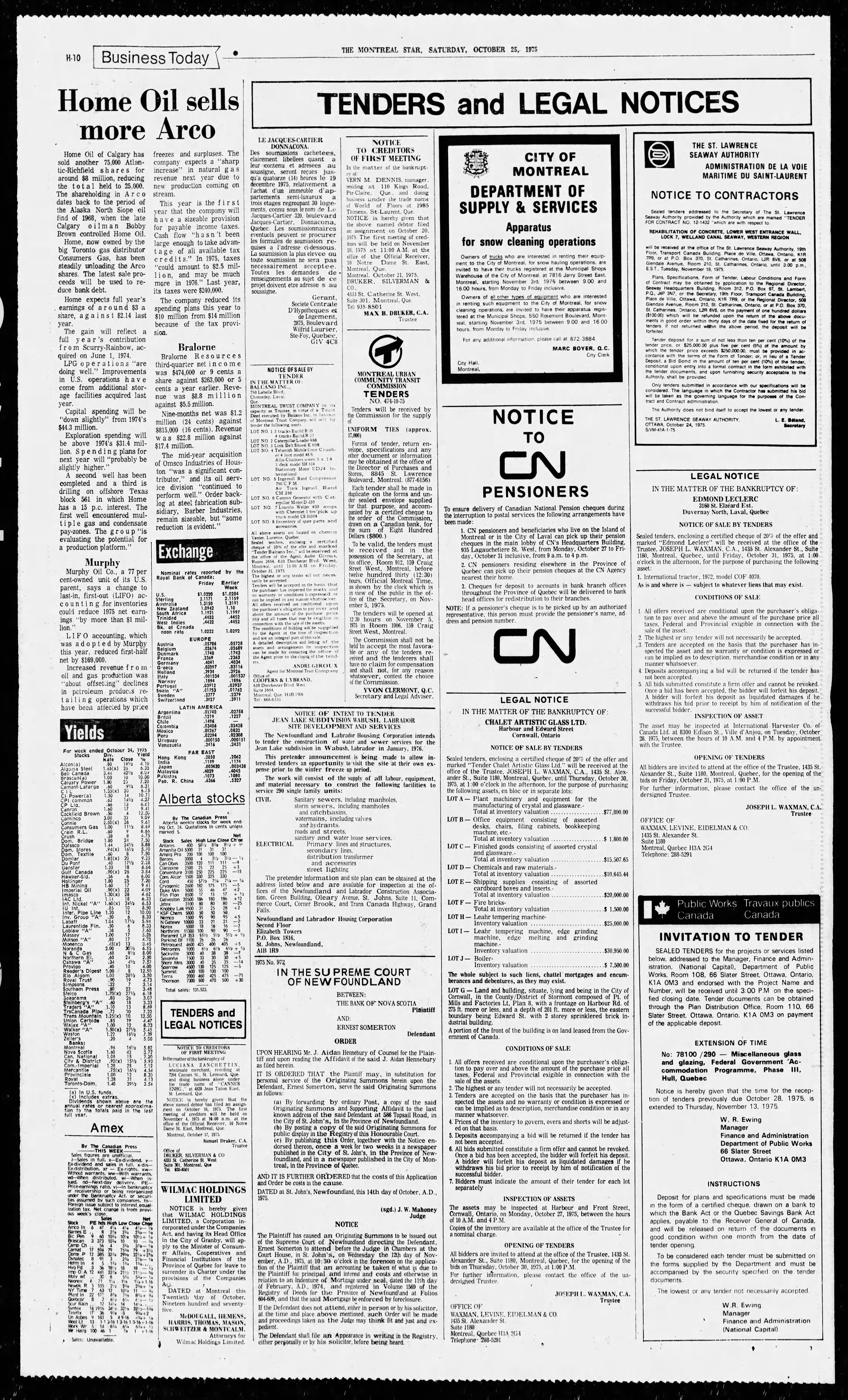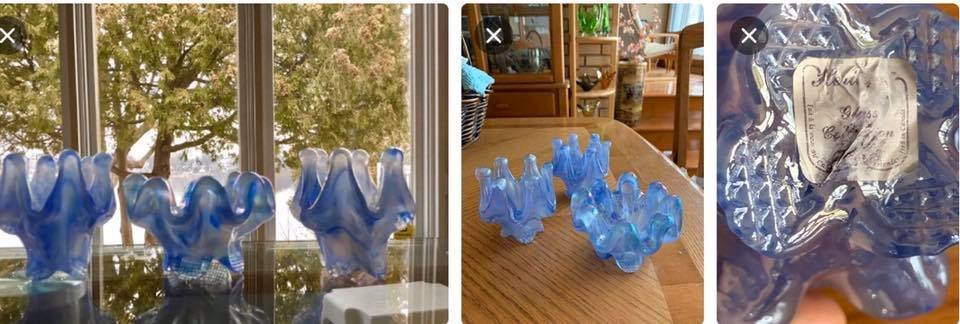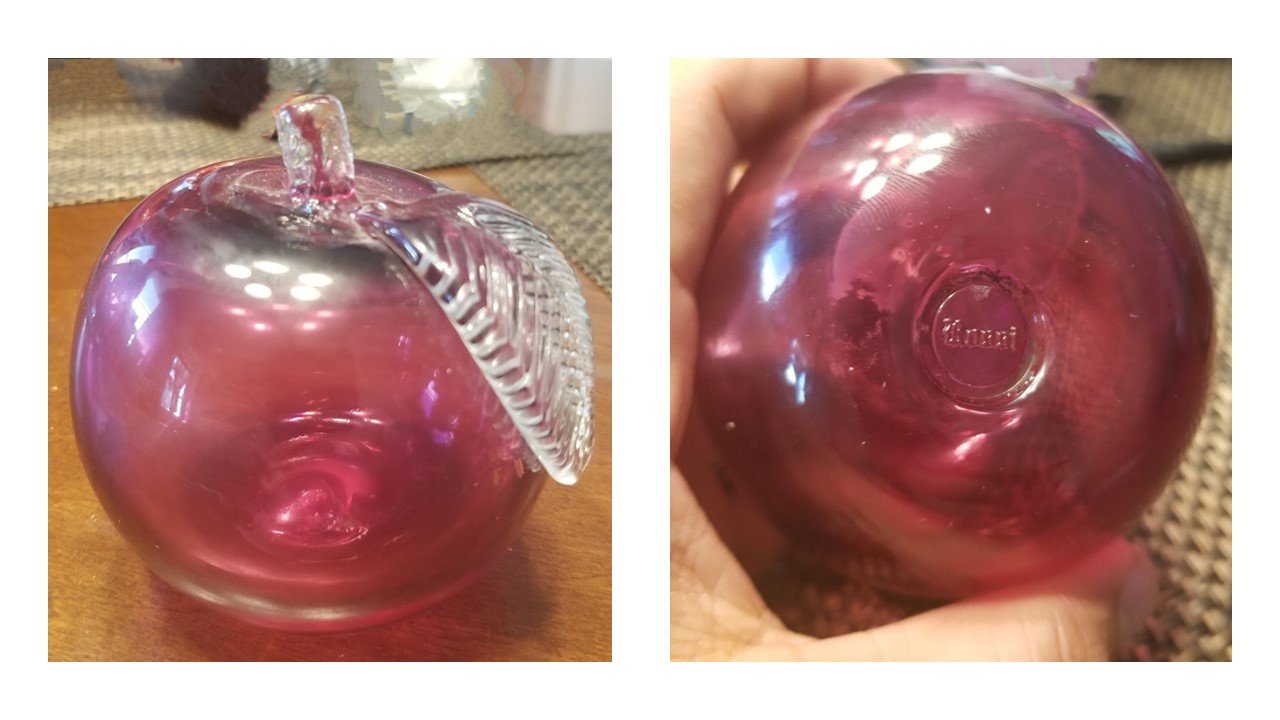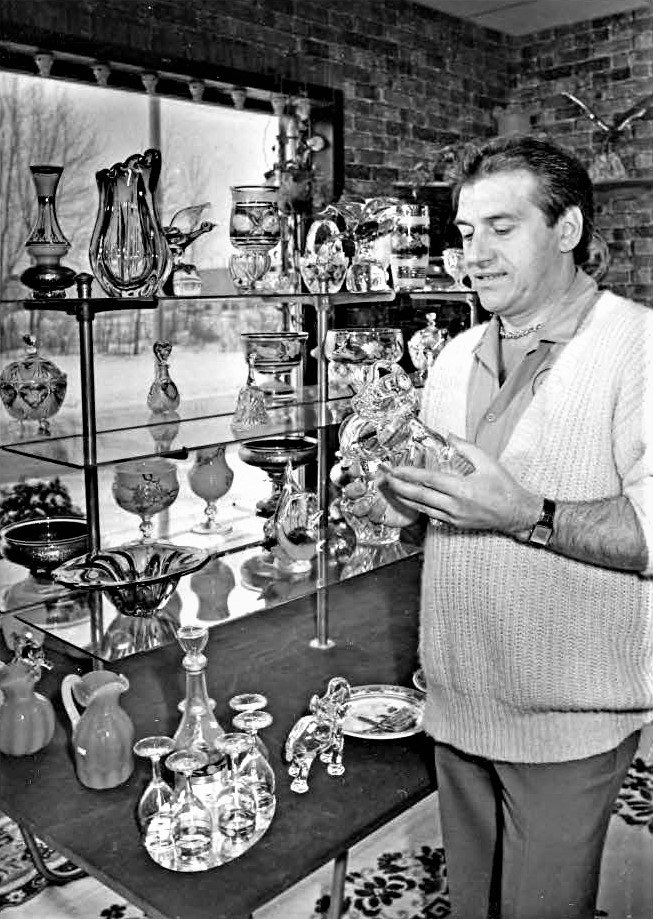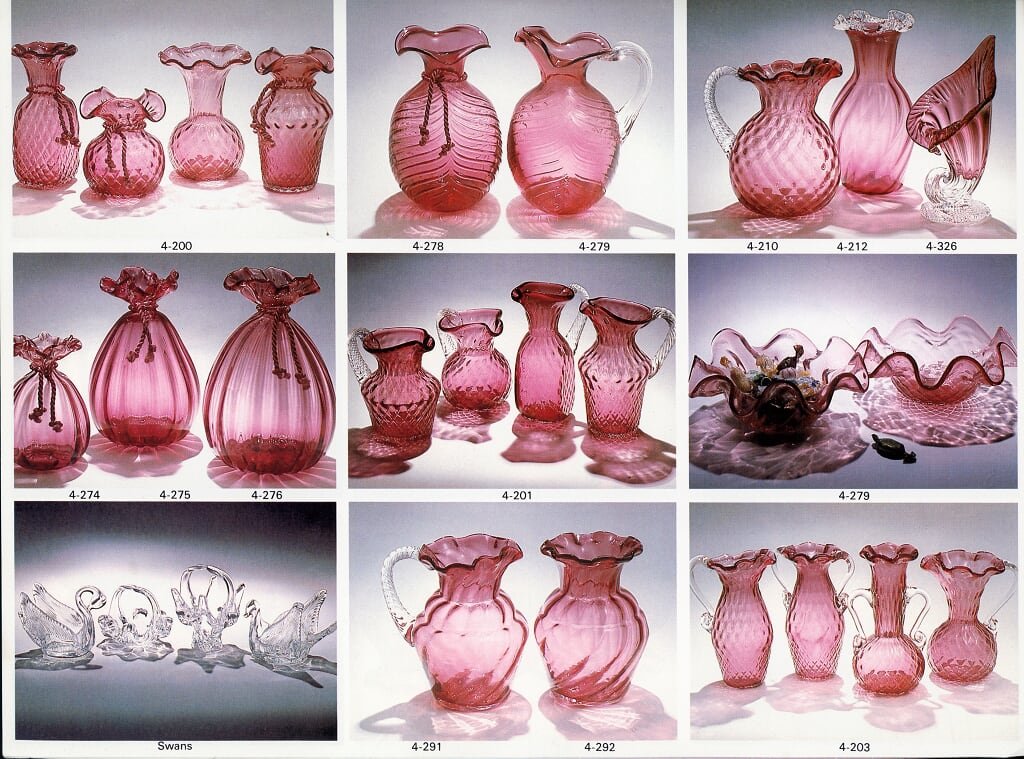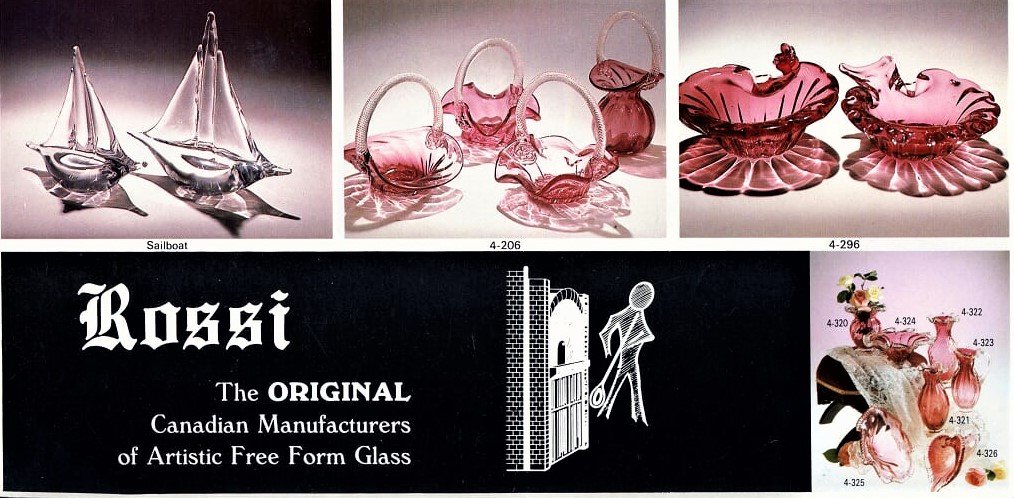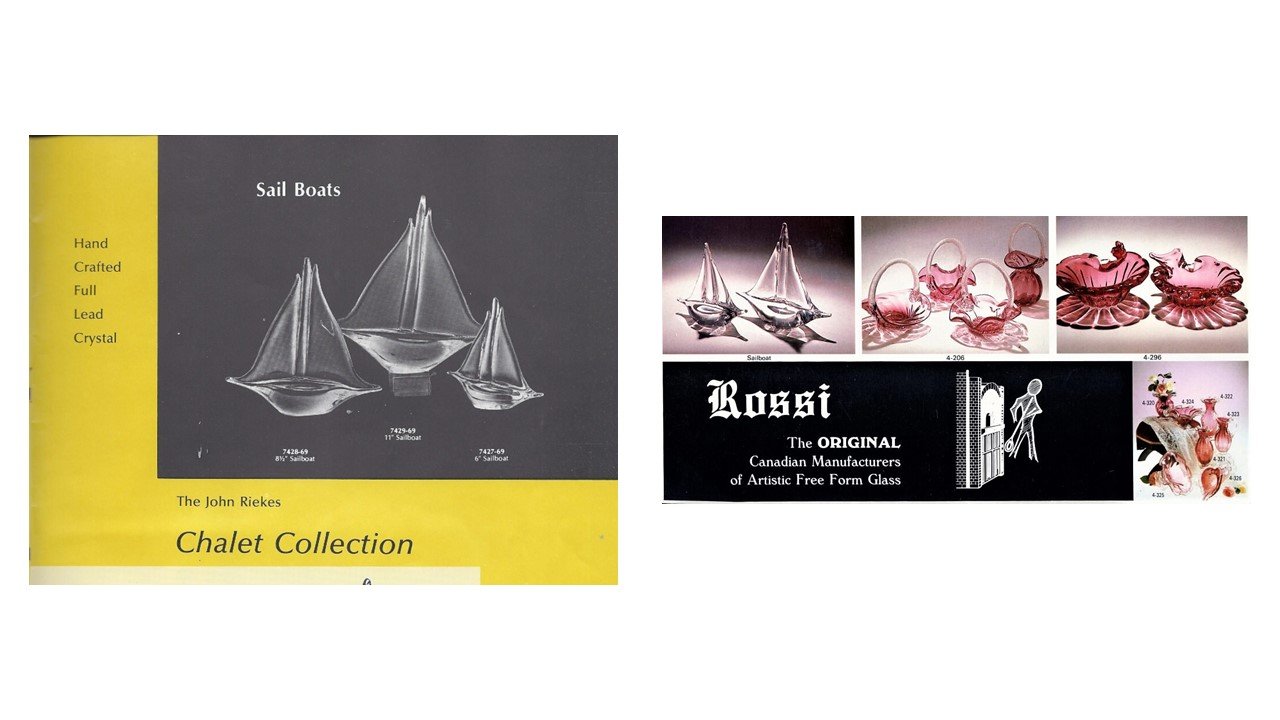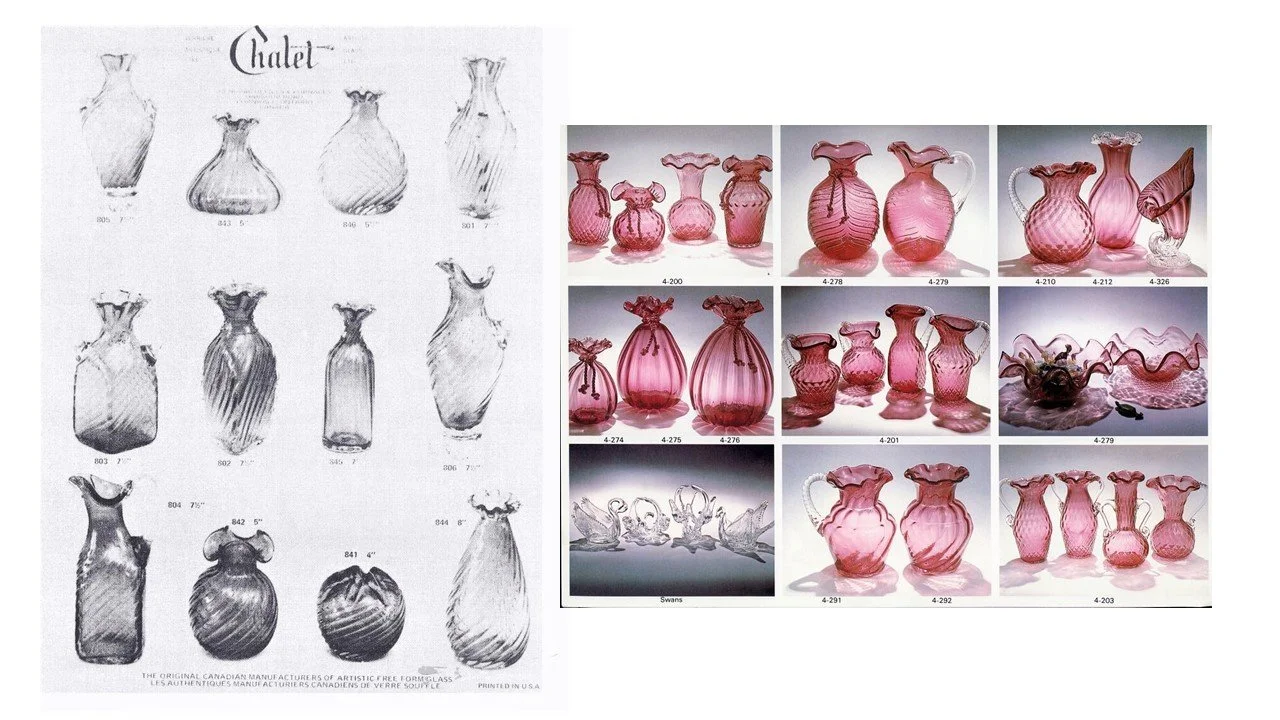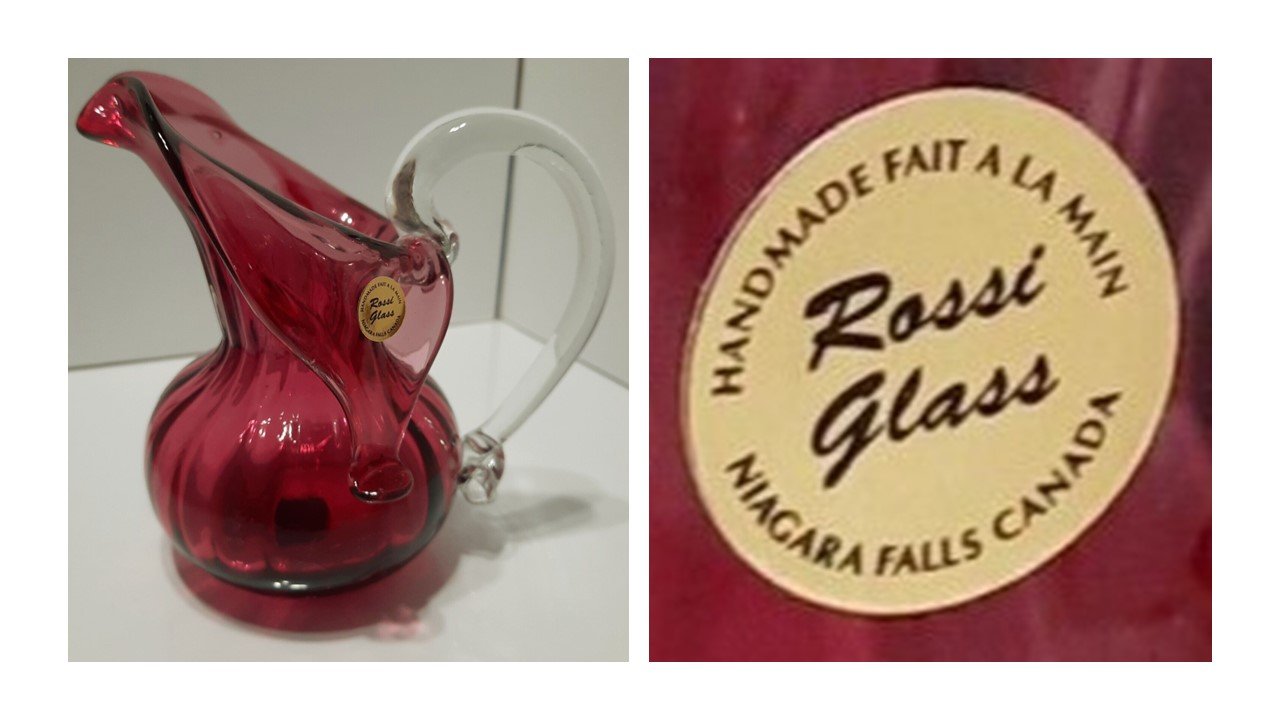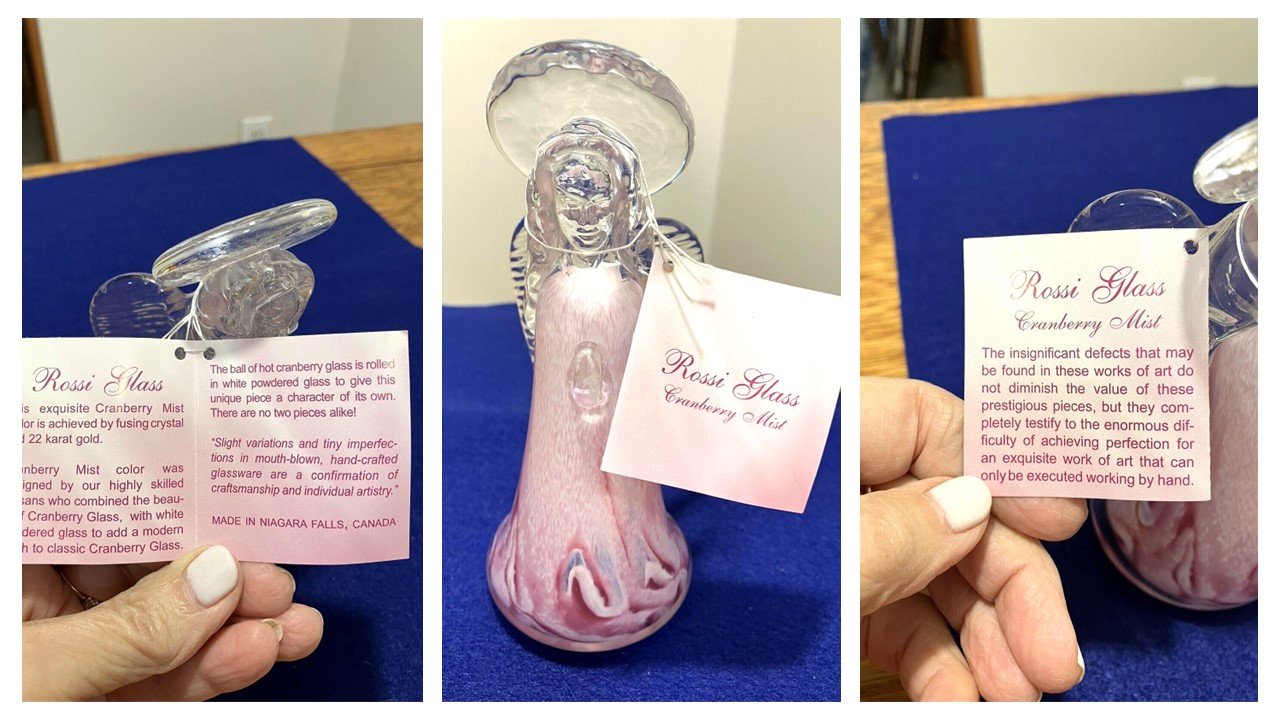The Chalet/Rossi Connections and Confusions
It is not uncommon to see assertions that Angelo Rossi founded and owned Chalet Artistic Glass or that the company operated well past 1975 as Angelo Rossi “took it over.” As both of these statements are incorrect, how did this confusion start? How were Chalet and Rossi connected? The confusion started with Rossi himself and quite deliberately. From the onset of Artistic Lighting (the first Cornwall glass house Rossi started with partner and businessman Morris Jaslow) after Chalet’s bankruptcy, he made an ongoing and concerted effort to piggy back on and profit from Chalet’s name and reputation. In spite of his undeniable talent as a glassblower and the fact that he achieved Maestro status while employed at Chalet, Rossi was not a founder, a co-owner, or any type of partner in Chalet Artistic Glass despite his personal claiming to the contrary. Other boasts such as Rossi Artistic Glass was the “... ORIGINAL Canadian Manufacturers of Free Form Artistic Glass” or bragging that he invented and/or was the first Canadian producer of cranberry glass are also patently untrue. Several such are shown below. He was also not Chalet’s company chemist – that was one of Chalet’s founders and owners – Maestro Sergio Pagnin. Rossi worked at Chalet as a glass blower, near the end of its operating, for a relatively short period of time. So, what were some possible motivations in creating confusion? The most likely – to capitalize, both with consumers and distributors, on Chalet’s already established position in the marketplace and the recognition of the general public’s tendency to take something in print as “gospel.” Confusion was created in quite a few ways. Specifically:
:through misleading advertising
:through brandings using similar company and product names
:through using similar logos and product descriptions
:through disingenuous comments in interviews
:Artistic Lighting opened in Chalet’s former location on Harbour Road and employed quite a few of the former Chalet artists
:Rossi and Jaslow bought Chalet’s equipment and outstanding finished inventory at Chalet’s bankruptcy sale
:the selling of Chalet’s outstanding inventory through Artistic Lighting and Rossi Artistic Glass
:through using some of Chalet’s former distributors and retailers
Some proofs:
Note the claim in the 1976 announcement on the heels of Chalet’s closure (at left) that “The former Chalet Artistic Glass has reopened as Chalet Artistic Glass Canada Ltd.” Rossi did not own the rights to the name “Chalet Artistic Glass” at any time. Hence adding “Canada Ltd.” Most of the general public probably would not even notice that the company names were different and/or what that signified. Courtesy of the Cornwall Community Museum.
The Chalet bankruptcy notice. Note the listing of both “… plant machinery and equipment for the manufacturing of crystal and glassware …” and “… finished goods consisting of crystal and glassware…”:
The 1975 bankruptcy notice for Chalet Artistic Glass. October 25, 1975, Montreal Star,
And as above as well:
Another major factor contributing to the confusion was that N. C. Cameron and Sons, one of Chalet Artistic Glass’s major distributors, subsequently distributed Rossi and Jaslow “Chalet glass” product.
Published in the Kitchener Waterloo Record, August 2, 1978. This newspaper is a division of the Postmedia Network.
And more as above:
Right out of the gate, the inaccuracies abound. Carefully read the cutline and the first paragraph of the following article run in the Standard Freeholder, May 14, 1977, a division of Postmedia Network, Inc.. From the archives of the Cornwall Community Museum.
Article is full of glaring omissions, misdirection and outright errors.
Given these overlaps and similarities, it may seem plausible to say, “Oh well, it really still was Chalet.” To the contrary, it cannot be more highly stressed that these were two separate companies entirely – both in spirit and practice as well as in product and lines. Chalet Artistic Glass ended with its closure in 1975.
Following Chalet’s end, for several year (1975-1979), Jaslow and Rossi (as “Artistic Lighting) produced a line of table lamps, ceiling fixtures and decorative art glass.
Artistic Lighting closed in 1979 after Rossi suffered a terrible work accident and returned to Italy. Maurice Jaslow continued producing art glass and lamps as Jaslow Glass Industries.
In 1981, Rossi was recovered from his injuries, and returned to Canada to open his second Cornwall glasshouse – Rossi Artistic Glass. It operated until 1994. Despite the passing of two years, the Chalet/Rossi confusion did not abate as Rossi continued to obfuscate Chalet Artistic Glass with Rossi Artistic Glass.
As seen in this February 1981 Standard Freeholder article, a division of Postmedia Network:
More of the same. As well, some familiar names and faces from Chalet, Saint-Zotique and Artistic Lighting.
Company structure of Rossi Artistic Glass:
Owner:
Angelo Rossi
Glassblowers: as known
Maestro Angelo Rossi (former Chalet artist )
Maestro Giulio Gatto (former Chalet, Saint-Zotique artist)
Roberto De Marchi (former Chalet, Saint-Zotique artist)
Antonio Tedesco (former Chalet artist)
Gianfranco Guarnieri (former Chalet artist)
Paul Gravel (former Chalet, Saint-Zotique artist)
Marcel Gravel (former Chalet, Saint-Zotique artist)
Giovanni Voltalina (former Chalet, Saint-Zotique artist)
Joanne Brown
Robert Campeau
Mike McEwen (former Chalet artist)
Michael Bathurst
Mike Kuhn
Carrel Doerbecker
Shipping/Showroom Employees: as known
Irma Tedesco. (former Chalet employee)
Once again, this Chalet/Rossi confusion resulted through Rossi’s use of company names and corporate imagery, and product lines and descriptions that were similar to those that had been used by Chalet. And, as seen above, many glass artists that had worked with Rossi at Chalet and for him at Artistic Lighting returned to join this new venture. However, the location of this second company was not the former Chalet Harbour Street factory where he had operated Artistic Lighting. Rossi Artistic Glass was located at 450 7 Street West.
1982 Bell Canada “Yellow Pages” directory listing. From the archives of the Cornwall Community Museum.
As stated above, misperceptions were fueled by Rossi’s habit of incorporating naming and images for both his products and businesses similar to those which Chalet had used. Rossi closely emulated Chalet’s image of a glass blower with a canna.
Not only on his business cards:
From the digital archives of the Cornwall Public Library.
But also on his catalogue pages:
A blatantly false claim. From a 1988 Rossi Artistic Glass catalogue page. Courtesy of the Cornwall Community Museum.
And then on the physical branding of his product:
Some examples of company naming similarities that cause confusion:
Until 2004, Rossi used “Artistic” in all his company names:
Artistic Lighting (Cornwall), Rossi Artistic Glass (Cornwall), and Artistic Glassblowing Studio (Niagara Falls).
Some examples of product naming similarities that cause confusion:
Chalet had lines called “Canadian Heritage Glass” and “Canadiana Cranberry” which were emulated by Rossi naming his cranberry lines “Heritage Cranberry Collection” and “Canadian Cranberry Collection.” Very often vintage Chalet “Canadiana CRANBERRY GLASS” pieces missing their original hang tags are mistakenly identified as “Rossi cranberry.”
The overlap between former Chalet distributors and retailers also continued.
The Toronto Star, June 28, 1983. This newspaper is a subsidiary of Torstar Corporation and part of Torstar's Daily News Brands division.
Like Chalet, Rossi used paper and foil stickers and card stock hangtags. However, he did not use a base etching although base impressions and hand engraving was used.
This rectangular white paper label with red lettering was the earliest sticker used:
This paper label is rarely seen as it was used for only a brief time. From the collection of 50 Shades member Jackie Lyn.
The more commonly seen “Rossi Artistic Glass” sticker:
Small oval gold foil label. Please note that this branding does not stipulate “Rossi Artistic Glass” but just “Rossi” and says “Cornwall, Ontario. Made in Canada” rather than just “MADE IN CANADA” as the earliest label.
Photographs courtesy of 50 Shades members Geoffrey Chown and David Dunkley.
Photographs of this lovely dog figurine courtesy of 50 Shades member Very Merry Vintage.
Early branding of the Rossi Artistic Glass cranberry line:
This label is very interesting as it does not indicate a company name. However, it is not a generic label. It is a Rossi company label and not designating a company name is something that was done on numerous of Rossi’s other brandings. This also adds to confusion, example follows, as these types of Rossi stickers are easily and often mistaken for generic labels. Not a frequently found label.
This cranberry Rossi “bridal basket” being mistaken for a Chalet piece is a very understandable misidentification since the label is no help at all regarding maker and the form is common to both. The label in all probability was likely mistaken by the seller for a generic label indicating country of origin manufacturing.
The following label is the later sticker that is found on Rossi Artistic Glass cranberry pieces.
Note that while it is different in appearance from the one above, the product line is still called “Heritage Cranberry Collection” and this later label also does not designate a maker.
The “Keepsakes” hang tag was also used on many pieces of cranberry. However, this is a rarely found marking:
Cassidy’s Ltd. Was established in 1801. At that time, the bulk of their business was importing china and glass goods from Britain. Based in Brossard, Que., but managed out of Toronto, Cassidy's closed in 2000 marking the end of what was a 199-year-old business: a business cited as the third oldest in Canada. Despite its many years of operation, Cassidy’s never acted as a Chalet distributor.
Rossi used the descriptive “Heritage” in two other lines:
Firstly, for the Rossi Artistic “Heritage Glass Collection” branding:
Photographs courtesy of 50 Shades member Josh Dolstra.
This sticker is also frequently found on Rossi bombonniere.
And secondly, on the “Heritage Cranberry Mist” line.
Pieces from this line could also be given a hang tag. However, to date, I have not found a Rossi Artistic Glass “Heritage Cranberry Collection ” nor a “Heritage Glass Collection” hang tag.
As stated above, Rossi also used base impressions. Two different markings:
His full last name:
A cranberry apple that Chalet and Rossi artist Roberto Di Marchi made while at Rossi Artistic Glass. It remains in the possession of the Di Marchi Family.
Or just the initial “R”:
The initial could also be reversed - as we have seen with two of Chalet’s etched signatures. The reverse Rossi initial impression is a rarely seen branding.
These two pieces, cranberry bowls of similar but not identical design, show the different initial impressions.
Rossi would also hand engrave his pieces with his signature if asked.
As with Chalet, factory tours were exceedingly common. The showroom at the Rossi factory was much more elaborate than the one at Chalet had been. It was a proper retail space and where 99% of Rossi sales in Cornwall were realized.
And also, as Chalet had done, Rossi held annual Christmas sales from his factory showroom. Published December 1, 1981 in the Standard Freeholder which is a division of the Postmedia Network, Inc.
From the archives of the Cornwall Community Museum.
As stated above, Rossi sold pieces of the finished Chalet inventory that he had purchased in 1975 at that company’s bankruptcy sale. This was done at both Artistic Lighting (shown in ad above) and at Rossi Artistic Glass:
Note the pitcher at top left. It retains a Chalet N. C. Cameron label:
1981 Retail showroom Rossi Artistic Glass, Cornwall. Courtesy of the Cornwall Community Museum.
1981. Maestro Angelo Rossi in the retail showroom of Rossi Artistic Glass. Cornwall. Courtesy of the Cornwall Community Archives.
Retail showroom of Rossi Artistic Glass. Cornwall, 1981. Once more, other Chalet pieces (2 vases on bottom shelf with the same Chalet labels as shown above) are on display for purchase. You can also see pieces here such as the lamps that were made earlier at Artistic Lighting. This photograph is also courtesy of the Cornwall Community Archives.
Unlike Chalet, I have found no historical advertising from local or regional retailers for Rossi product and when I asked Cornwall natives and residents if they remember seeing Rossi product in Cornwall retail establishments, they replied “No.” And these are informed sources – Chalet, Saint-Zotique and Rossi artist Roberto De Marchi, Paolo De Marchi (who worked with his father at Rossi during summers), Cornwall natives and 50 Shaders Jeremiah Shaver and the curator of the Cornwall Community Museum, Don Smith. Cornwall sales were done through the factory showroom.
I am unsure what the “Elly’s Favourites” label on this little bomboniere indicates. Is it a boutique label or another Rossi branding? We have established that it is not from any retail store in Cornwall operating at that time. However, Jeremiah Shaver suggested it could be from a US gift shop as Cornwall is on the Canadian/American border. As likely as not. However, no one can shed any light on it other than to confirm it was not from a Cornwall retail establishment.
We are fortunate to have some 1988 Rossi Artistic Glass catalogue pages for reference.
Although the most often found Rossi pieces of any era are various cranberry vases, baskets, centerpieces, pitchers and ashtrays, swan, and fruit, Rossi Artistic Glass also produced bomboniere, sailboats, Christmas trees, lamps and animal figurines such as elephants, dolphin, horse heads and dogs. However, please note that Rossi did not produce heavy leaded “stretch” pieces as had Chalet. Another difference between Chalet/Rossi products is that the majority of his bomboniere have an irradato finish or are opaline. A few of Rossi’s signature colours are cobalt, bight yellow, emerald-green and purple. Rossi olive green, amber and orange pieces are not typical.
Catalogue pages courtesy of 50 Shades member, Don Smith, curator of the Cornwall Community Museum.
It is always fun to find unmarked pieces that can then be identified or verified through a catalogue page:
Inventory #4296.
Chalet “bridal” basket on left. The misidentified Rossi produced piece (shown earlier) on right.
An extremely rare Rossi produced table lamp that has survived the passage of time.
Photographs courtesy of 50 Shades member Jeremiah Shaver.
A closer look at some Chalet Artistic Glass produced pieces in comparison to Rossi Artistic Glass produced pieces. Confusing connections indeed!
Rossi produced piece on left from the collection of 50 Shades member Kevin Kodak. Chalet produced bomboniere on right.
Not only did both companies produce clear crystal sailboats as shown in these catalog pages, but cranberry sailboats can also be found from both companies.
Rossi produced piece on left. The Chalet produced sailboat on right from the collection of 50 Shades member Nick Mucciante.
Chalet “Canadian Heritage Glass” catalogue page on left and Rossi catalogue page on right.
Rossi pieces at left and top middle. Chalet pieces at right and bottom middle.
Rossi produced piece, shown previously, on left courtesy of Josh Dolstra. Chalet produced piece on right.
Rossi produced piece on left. Chalet produced piece on right.
Bomboniere “confusers”:
Rossi produced piece on left. Chalet produced piece on right.
Chalet produced and Chantili distributed piece on left. Rossi produced piece on right from the collection of 50 Shades member Karen Jones.
Rossi pieces at top left and right. Chalet pieces at bottom left and right.
Rossi also produced pieces in opaline with “cranberry splatter.” Some are identical in form to those done by Chalet. However, there are marked differences as the Rossi pieces have a glassy, highly reflective finish and the cranberry splatter is not as richly coloured and/or plentiful.
Photograph courtesy of 50 Shades member Kevin Hall.
Chalet produced piece on left from the collection of 50 Shades member Bob Burgess. Rossi produced piece on right.
Chalet hand molded vase, left, from the collection of Melissa Patterson.
In 1994, Rossi closed down Rossi Artistic Glass and left Canada to return to Italy. His return to Italy, however, was quite short: lasting a mere two years. In 1996, he returned to Canada but, not this time to Cornwall, and, with partner Marty Sicurella opened a glassblowing studio, Artistic Glass, in Niagara Falls.
The partnership was extremely contentious and Rossi left the company in 2001.
In 2004, he returned to Niagara Falls and opened Artistic Glassblowing Studio. Although the Niagara Rossi glasshouse pieces are not vintage in age, pertinent information is included here to avoid further confusion regarding their timeline and maker.
With this new business, no other partners were involved. However, he was not “the only game in town” as Artistic Glass was still operating, and several other glassblowing studios had opened in Niagara Falls over the years.
Ironically, due to confusion due to name similarity, Rossi changed his company’s name after about a year to Rossi Glass. For a brief time at Rossi Glass, artists Antonio Tedesco and Roberto De Marchi worked for Rossi. However, the distance from their homes in Eastern Ontario proved very problematic, and they did not stay with the new Rossi glasshouse.
After leaving the partnership, Rossi also left Niagara Falls and Canada to lecture about glass blowing in several American universities as well as working as a consultant from 2003-2005 with world-renowned Fenton Glass.
In 2004, he returned to Niagara Falls where he opened Rossi Glass. With this new business, no other partners were involved. However, he was not “the only game in town” as Artistic Glassblowing Studio was still operating and quite a few other glass blowing studios had opened in Niagara Falls over the years. Although Rossi Glass pieces are not yet vintage in age, pertinent information is included here so that further confusion regarding their timeline and maker is avoided.
For a brief time at Rossi Glass, former Chalet artists Antonio Tedesco and Roberto De Marchi once again worked for Rossi. However, the distance from their homes in Eastern Ontario proved very problematic and they did not stay with the new Rossi company.
Roberto De Marchi at Rossi Glass, Niagara Falls, circa 2005. Photograph courtesy of Paolo Di Marchi.
Establishing Rossi Glass so many years later still did not mark the end of Rossi’s boasts and deception. He continued to mislead and rewrite history.
Clearly demonstrated by these comments he made December 3, 2009, to a St. Catherine’s news paper reporter from “Niagara Weekly” :
Firstly, that: “After spending my youth in Italy, I moved to Canada in 1971 and decided to open a glass blowing studio in Cornwall, Ontario. I also started two glass factories, one called Chalet Glass and the other Artistic Lighting.” In 1971, Rossi was briefly an employee first at Lorraine Glass Industries before moving to Cornwall and working for, not founding, owning, or partnering with, Chalet Artistic Glass. He did indeed open Artistic Lighting with Maurice Jaslow but that was in 1976.
Secondly, in this same article, Rossi also claims to have introduced cranberry glass to Canada. The article states (wrongly) : “In 1990, he started a new company called Rossi Glass.” We know that in 1990 Rossi was still in Cornwall and still operating Rossi Artistic Glass which he had opened in 1981. However, that is the least of the article’s inaccuracies as Rossi is cited as claiming: “My glass blowing studio became the first and only manufacturer of cranberry glass in all of Canada,” he said. “The cranberry glass made with the addition of 22 carat gold, soon became a famous, highly collectable work of art.”
Angelo and Diane Rossi, 2009, at the time of the Niagara Weekly article.
The branding for this new company was extensive and varied. Foil stickers, card stock hangtags, base impressions and hand engraved signatures are commonly found. However, once more, no base engraving was done.
The marketing and branding of the products went much farther and was more professional than that seen in his earlier companies.
Original box, 2004.
Original showroom display plaque.
Showroom displays were coordinated with marketing and branding materials:
Even during this “Golden Age” era for Rossi glass, his “Chalet” roots peek through:
Rossi produced set on left. Chalet produced pair on right from the collection of 50 Shades Troy Danby.
Rossi produced piece on left. Chalet produced set on right
Rossi produced piece on left. Chalet produced set on right
If this basket did not retain a Rossi Glass sticker, a logical “Identity assumption” would certainly be Chalet as identical in form to this style made at Chalet.
Angelo Rossi at work at Rossi Glass, Niagara Falls. Circa 2010.
An anomaly – this “Keepsakes” hang tag used in Cornwall by Rossi Artistic Glass (1981-1994) is seen on a piece which also bears a “Rossi Glass” foil label which was not in operation until 2004.
The most frequently seen Rossi Glass hall mark:
A small round gold foil sticker. It can be found on its own or on pieces that have hang tags and base impressions as well. In fact, it is as common as not to find a Rossi Glass piece with at least two markings.
Much less often, a piece is found with this label in silver not gold foil.
The most commonly found hang tag on Rossi Glass cranberry pieces is the “Rossi Glass. Canadian Cranberry Collection.”
As stated above, it is very typical to find pieces that bear more than one Rossi marking. This particular vase bears three as not only is it stickered and given a hang tag, its base is also impressed with the initial “R”.
Once again, there was more than one branding for the same line of product. Another for the Rossi Glass cranberry was “Cranberry Lane”:
This vase retains both its original hang tag and sticker. The Canadian distributor for the cranberry is now “Century Universe Corporation” as Cassidy’s was defunct. Other than its location, Malton, Ontario, there is no information available regarding this company.
A familiar branding. The Cranberry Mist” line of product was also produced earlier at Rossi Artistic Glass.
A totally new line. “Rossi Glass Exclusive Collectibles”:
As seen at Rossi Artistic Glass, Rossi continued to use the same two base impressions:
The name Rossi.
And the initial “R”. However, please note that I have found no reverse initial impressions on Rossi Glass products as was used in Cornwall on Rossi Artistic Glass pieces.
Studio tours and demonstrations continued to play a huge role.
Therefore, personal signings remained popular:
It is even possible to find pieces with signatures from other artists that worked for Rossi:
The company was renamed Angelo Rossi Galleria and Studio in 2011. Some branding changes resulted.
Small round silver stickers were now used as well. The “Rossi Glass Exclusive Collectibles” line became “Angelo Rossi Collectibles.” And on hang tags, an “Angelo Rossi” signature was now featured.
Another new branding for the Rossi cranberry. The “Canada. Angelo Rossi” hang tag:
A fitting note on which to end, Maestro Rossi retired in 2022 and moved to Smooth Rock Falls, north of Timmins, Ontario.
